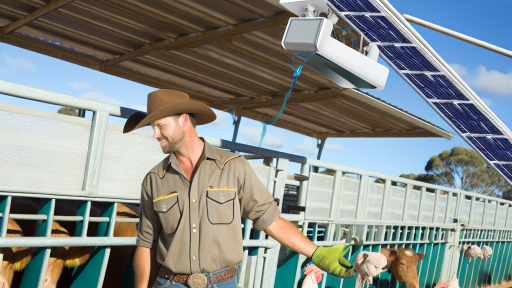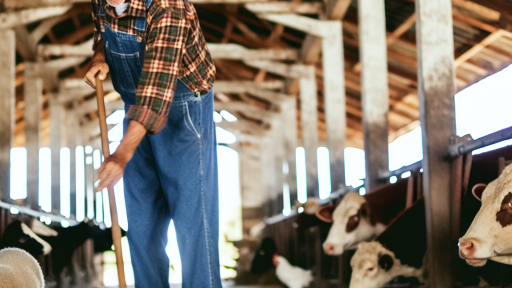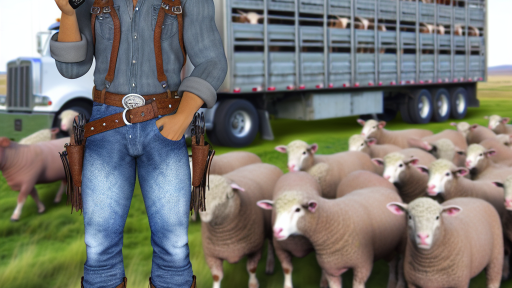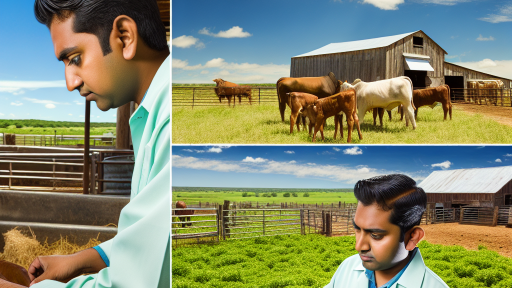Understanding Genetic Principles in Livestock Breeding
Importance of Genetics
Genetics plays a crucial role in livestock breeding.
It influences the quality and traits of animals.
Understanding genetics helps farmers make informed decisions.
Basic Genetic Concepts
Every animal inherits genes from its parents.
These genes determine various physical and behavioral traits.
Traits can be classified as qualitative or quantitative.
Qualitative traits include color and horn presence.
Quantitative traits are measurable, such as weight and milk yield.
Heritability and Selection
Heritability is the proportion of variation in traits due to genetics.
It affects how effective selection is in improving traits.
Higher heritability means better chances for improvement.
Farmers should use selection techniques carefully.
They must choose the right breeding stock based on desired traits.
Breeding Strategies
Several breeding strategies exist for livestock improvement.
Purebreeding maintains specific breed characteristics.
Transform Your Agribusiness
Unlock your farm's potential with expert advice tailored to your needs. Get actionable steps that drive real results.
Get StartedCrossbreeding can produce hybrid vigor.
Hybrid vigor enhances productivity and fertility.
Farmers must evaluate which strategy fits their goals.
Utilizing Technology
Technological advances offer new tools for genetic improvement.
DNA testing helps identify desirable traits in livestock.
It allows farmers to make better breeding choices.
Additionally, software can aid in tracking genetic lines.
This data-driven approach enhances breeding programs.
Selecting the Right Breeding Stock
Importance of Selecting Breeding Stock
Choosing the right breeding stock is crucial for any farmer.
It directly affects the quality and productivity of livestock.
Farmers should evaluate several factors before making a selection.
Understanding Traits and Characteristics
Farmers should prioritize specific traits when selecting breeding stock.
These traits may include growth rate, disease resistance, and temperament.
Understanding these characteristics helps in breeding successful livestock.
Evaluating Health and Genetic Background
The health of breeding stock should be a top priority for farmers.
Choose animals that show no signs of illness or genetic defects.
Conduct health screenings to ensure the stock is disease-free.
Genetic background can impact the productivity of livestock.
Review pedigree records to assess genetic traits and variability.
Assessing Performance Data
Farmers should analyze performance data before selecting breeding stock.
Look for data on weight gain, milk production, and overall efficiency.
This data can provide insights into the potential of the breeding stock.
Consider the performance of both parents when making your decision.
Considering Breeding Goals
Clearly define breeding goals to guide your choices.
Showcase Your Farming Business
Publish your professional farming services profile on our blog for a one-time fee of $200 and reach a dedicated audience of farmers and agribusiness owners.
Publish Your ProfileYour goals may include improved growth rates or enhanced disease resistance.
Align your breeding stock selection with these specific goals.
This approach ensures that you meet your production needs effectively.
Utilizing Expert Advice
Consulting with livestock specialists can enhance your breeding decisions.
Experts can provide valuable insights into breed selection and management.
Additionally, local agricultural extension offices offer resources and guidance.
Networking with experienced farmers can also prove beneficial.
Creating a Breeding Program: Goals and Planning
Defining Objectives
Every successful breeding program starts with clear objectives.
Determine what traits you want to enhance in your livestock.
Common goals include improving growth rates and disease resistance.
Additionally, consider the desired market characteristics for your animals.
Assessing Resources
Next, evaluate your available resources for breeding.
This includes both financial resources and physical space.
Understand the labor requirements for effective breeding management.
Also, consider the genetic diversity available within your herd.
Choosing the Right Breeding Methods
Different breeding methods can achieve different objectives.
Natural breeding allows for animal selection based on traits.
Artificial insemination provides access to superior genetics.
Further, embryo transfer can enhance genetic progress.
Developing a Breeding Timeline
A structured timeline is essential for successful breeding.
Establish milestones for breeding cycles and evaluations.
Plan for seasonal changes that may affect breeding success.
Regularly review and adjust your timeline as needed.
Monitoring and Evaluation
Monitoring progress is critical for achieving your goals.
Regularly evaluate the performance of bred livestock.
Use data to assess whether your breeding objectives are met.
Adjust your strategies based on observed outcomes.
Delve into the Subject: Regulatory Compliance and Standards in Aquaculture
Best Practices for Breeding Record Keeping
Importance of Detailed Records
Maintaining detailed records is essential for effective livestock breeding.
Accurate records help farmers track lineage and performance.
They also assist in making informed breeding decisions.
Essential Information to Record
Farmers should note each animal’s identification details.
This includes breed, birthdate, and health history.
Breeding performance records are also crucial.
Documenting breeding dates and outcomes can guide future choices.
Tracking Genetic Traits
Farmers must record genetic traits of both parents.
This information helps enhance desirable characteristics in offspring.
Traits such as growth rates and disease resistance are vital.
Utilizing Technology
Technology simplifies record-keeping processes for farmers.
Software programs and apps can streamline data management.
Showcase Your Farming Business
Publish your professional farming services profile on our blog for a one-time fee of $200 and reach a dedicated audience of farmers and agribusiness owners.
Publish Your ProfileThese tools enable easy retrieval and analysis of breeding data.
Regular Review and Updates
Consistent review of records ensures accuracy.
Farmers should update records following new events.
This includes births, health changes, and breeding results.
Training Staff
Training staff on record-keeping practices is beneficial.
Everyone involved should understand the importance of accurate records.
Consistent methods lead to more reliable data and decisions.
Compliance and Standardization
Understanding local regulations regarding record-keeping is essential.
Farmers should keep records that comply with industry standards.
This compliance helps improve credibility with buyers and auditors.
Gain More Insights: Choosing the Right Exotic Livestock for Your Farm
Utilizing Artificial Insemination: Techniques and Benefits
Overview of Artificial Insemination
Artificial insemination (AI) is a reproductive technology used in livestock breeding.
This method involves collecting semen from a male and introducing it into a female’s reproductive tract.
A key advantage of AI is its ability to enhance genetic diversity.
Additionally, it allows farmers to select superior genetic traits for breeding.
Techniques for Successful Artificial Insemination
Proper technique is crucial for effective artificial insemination.
Farmers should begin by ensuring overall reproductive health of the animals.
Additionally, they must select the appropriate time for insemination.
Using estrus detection aids can significantly improve timing accuracy.
Preparation of Equipment
Cleanliness is essential when preparing AI equipment.
Farmers should ensure all tools are sterile before use.
A good practice is to warm the semen to body temperature prior to use.
Moreover, using a good quality insemination gun is critical for success.
Insemination Process
The insemination process should be handled with care.
Start by properly restraining the female to ensure safety and comfort.
Insert the insemination gun gently into the reproductive tract.
Deposit the semen at the appropriate location in the uterus.
Benefits of Artificial Insemination
Artificial insemination offers numerous benefits to livestock farmers.
First, it reduces the risk of disease transmission compared to natural breeding.
Second, it allows access to a wider range of genetics without having to maintain multiple males.
This method can also optimize breeding schedules for higher productive efficiency.
Economic Advantages
AI can lead to significant cost savings for farmers.
It eliminates the need for maintaining bulls on the farm.
Consequently, this reduces feed, care, and housing expenses.
Improved Genetic Quality
Access to superior bull genetics is a major advantage of AI.
This improves herd quality over generations, leading to better production traits.
Farmers can selectively choose genetic lines that match their needs.
Moreover, this enhances overall herd performance and profitability.
Delve into the Subject: Building Durable Livestock Housing Structures

Managing Inbreeding: Avoiding Genetic Bottlenecks
Understanding Inbreeding
Inbreeding occurs when closely related animals mate.
Showcase Your Farming Business
Publish your professional farming services profile on our blog for a one-time fee of $200 and reach a dedicated audience of farmers and agribusiness owners.
Publish Your ProfileThis mating method can reduce genetic diversity.
As a result, it may lead to detrimental traits.
Farmers must recognize these risks to their herds.
The Impact of Genetic Bottlenecks
A genetic bottleneck restricts the gene pool.
This situation generally arises from limited breeding options.
Consequently, it can increase the likelihood of inherited disorders.
Healthy livestock populations benefit from genetic variety.
Strategies to Avoid Inbreeding
- Implement rotational breeding practices.
- Introduce new bloodlines regularly.
- Maintain detailed records of lineage.
These strategies will help improve genetic diversity.
Additionally, they promote overall herd health.
Monitoring Genetic Health
Regular assessments ensure that breeding strategies are effective.
Test for genetic disorders in animals before breeding.
Use genetic analysis tools available for livestock.
Furthermore, collaboration with veterinarians offers insights.
Promoting Diverse Breeding Practices
Diverse breeding enhances adaptability to environmental changes.
Farmers should engage with broader breeding networks.
Education on genetics can lead to better decision-making.
This knowledge empowers farmers to optimize livestock genetics.
See Related Content: Sheep Shearing Best Practices for Farmers
Health Management in Breeding Animals
Importance of Health Management
Health management plays a vital role in successful livestock breeding.
Healthy animals produce better offspring consistently.
Moreover, good health reduces the risk of disease transmission.
This, in turn, enhances farm productivity and profitability.
Strategies for Effective Health Management
Implementing effective health management requires careful planning.
Firstly, regular health checks can identify issues early.
Veterinarians should carry out these checks routinely.
Secondly, maintaining proper nutrition is essential for animal health.
Balanced diets significantly improve reproduction rates.
Vaccination Programs
Vaccinations are critical in preventing infectious diseases.
Develop a vaccination schedule tailored to your livestock.
Always consult a veterinarian for the best vaccination practices.
Regular vaccinations can save your herd from serious health issues.
Biosecurity Measures
Implementing biosecurity measures protects livestock from external threats.
Control access to your farm to minimize disease exposure.
Establish strict hygiene protocols for all workers and visitors.
These steps can significantly limit pathogen introduction.
Monitoring Animal Wellness
Regularly monitor the health and behavior of animals on the farm.
Observe for any signs of illness or discomfort.
Quickly address any concerns to prevent further issues.
Use technology, like health tracking apps, for easier monitoring.
Education and Training
Educating farm staff on health management is crucial.
Showcase Your Farming Business
Publish your professional farming services profile on our blog for a one-time fee of $200 and reach a dedicated audience of farmers and agribusiness owners.
Publish Your ProfileProvide regular training sessions on animal care practices.
Knowledgeable staff can recognize health issues sooner.
Additionally, training improves the overall management of breeding animals.
Evaluating Breeding Outcomes
Importance of Monitoring
Monitoring breeding outcomes is essential for farmers.
This process helps determine the effectiveness of breeding strategies.
Moreover, it enables adjustments based on actual results.
Farmers should assess both genetic and environmental factors.
Collecting data on performance metrics is crucial for accurate evaluations.
Establishing Key Performance Indicators
Key performance indicators (KPIs) guide breeding evaluations.
Farmers should identify specific traits to monitor.
Examples include growth rates, fertility, and health status.
Setting clear benchmarks allows for effective comparison.
Additionally, regular reviews of these indicators help refine practices.
Adjusting Breeding Practices
Based on monitoring results, adjustments may be necessary.
Farmers should analyze which traits require enhancement.
Utilizing genetic data can inform better breeding decisions.
Changing breeding stock may also influence outcomes positively.
Furthermore, integrating feedback from peer networks can provide new insights.
Incorporating Technology
Technology plays a vital role in evaluating breeding outcomes.
Software solutions can simplify data collection and analysis.
Additionally, genetic testing tools offer deeper insights.
Farmers should explore advancements like DNA sequencing.
Using technology enhances precision and supports informed decision-making.
Continuous Learning and Improvement
Continuous education is vital for successful livestock breeding.
Farmers are encouraged to attend workshops and seminars.
Additionally, joining agricultural organizations fosters knowledge exchange.
Accessing resources from universities can further enrich understanding.
Lastly, committing to lifelong learning improves overall farm productivity.
Additional Resources
Three ways livestock farming is becoming more sustainable …
The Transformation of U.S. Livestock Agriculture: Scale, Efficiency …




